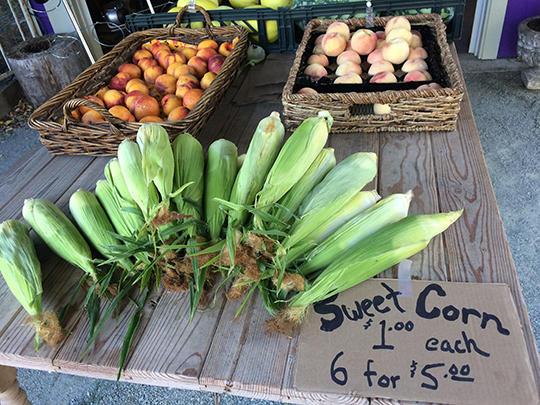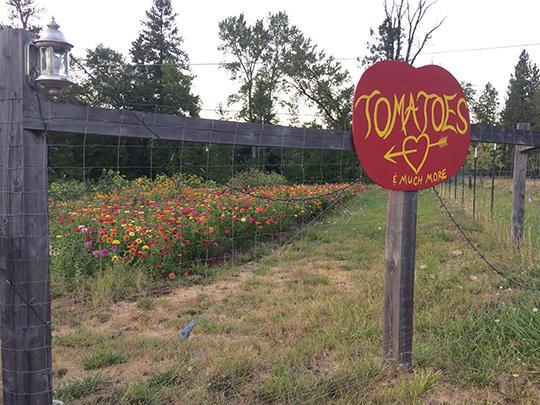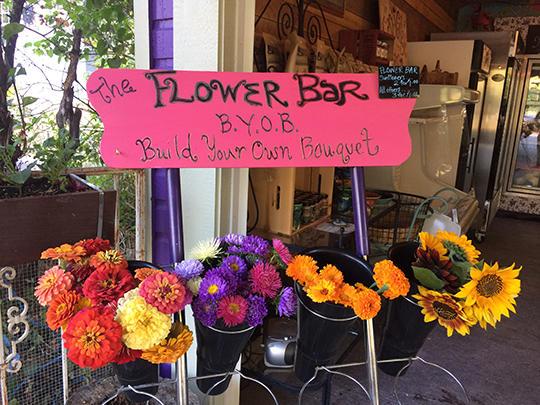Maud Powell, Extension Small Farms and associate professor of practice, Southern Oregon Research & Extension Center; and Melissa Fery, Extension Small Farms agent, Benton, Lane and Linn counties, and associate professor of practice, Department of Crop and Soil Science; both of Oregon State University
EM 9274 • March 2020
A farm stand can be an excellent way to sell your products directly to customers. If you have a good location and marketable products, a stand can help expand your customer base and improve your farm’s name recognition. Follow these steps to decide whether a farm stand is right for you and whether it could benefit your existing operation.
Lifestyle and location
Opening your farm to the public can affect your lifestyle — including your privacy and personal space. If you live on the farm, consider creating separation between the farm stand and your home with distance or visual barriers. Decide how comfortable you feel having customers explore the farm, and set boundaries for customers using signs, fencing or natural barriers. Clearly post days and hours of operation to deter early morning or late-night customers.
Think about your farm’s location. Most successful farm stands have a loyal community of people who support them. If your farm is on or near a road that gets significant traffic, your business may also attract visitors passing through the area. The farm stand’s curb appeal and a welcoming environment, with safe access off and back onto the road, will help draw customers. If you are counting on moving a lot of your products through your farm stand, location is critical.
Keeping legal and safe
The state of Oregon recognizes farm stands as important for the direct-marketing of farm products. But it also imposes many rules and regulations. Oregon law defines farm stands as structures “designed and used for the sale of farm crops or livestock grown on the farm operation, or grown on the farm operation and other farm operations in the local agricultural area.”
Farm stands range from simple, mobile structures used seasonally to sell one crop, to permanent buildings open year-round that sell many different farm products. Some farm stands are staffed with employees, while others rely on the honor system for payment.
Land-use permits. When working with your county to establish a farm stand, the most critical variable to research is your property’s zoning. Farm stands are an acceptable use on land zoned as Exclusive Farm Use, Rural Service and Rural Residential. Zoning will determine the permitting process, as specific rules pertain to each zone. Zoning also affects the cost of the required permits.
Permits on EFU properties allow for the sale of incidental retail items in the farm stand, such as bottled water or shopping bags with your farm logo. They also allow the use of fee-based activities to promote the farm stand, such as farm tours, food-preparation classes and outdoor farm-to-table dinners. However, income from these retail items and activities must not make up more than 25% of the farm stand’s total annual sales.
A permit for a farm stand consisting of off-street parking and signs, plus a card table and honor system of receiving payment may be less expensive than a farm stand that has a building structure. Permit fees depend on the county where the farm stand is located.
Building permits. Some farm stands are housed in existing buildings, while others are as simple as a sheet of plywood placed across two sawhorses under a shade tent. Your infrastructure depends on the quantity and makeup of the products you are selling. If you plan on having members of the public (customers) in your farm stand structure, the building code requirements may be more rigorous than for a structure meant only for product storage or display. Contact your local Building Division and Building official to confirm the specific requirements. Under Oregon law, farm stands can only be used for the sale of farm crops or livestock. “Farm crops or livestock” includes both fresh and processed farm crops and livestock grown on your farm operation, or grown on your farm operation and other farm operations in the local agricultural area. “Processed crops and livestock” includes jams, syrups, apple cider, animal products and other similar farm crops and livestock that have been processed and converted into another product but not prepared food items. Farm stands may not be used to host indoor public events or offer overnight accommodations.
Other permits may include floodplain, electrical, plumbing, mechanical, septic, or road approach.
Food safety. The Oregon Department of Agriculture’s Food Safety program will work with you to determine if your farm stand requires a food license. There are license exemptions if you are selling only fruit, vegetables, eggs and honey produced on your farm. If you are selling products from other farmers, or meat or milk products, check with your local food inspector to determine license and labeling requirements. If you plan to sell food for immediate consumption, such as baked goods that incorporate your farm produce, or for special events, you will need proper permits from your county health department. To help ensure food safety at your farm stand, always:
- Protect produce from pests, road dust and other environmental contaminants.
- Store food off the ground or in rigid containers.
- Provide washing stations for hands and produce.
- Consider what is needed to keep your products fresh, including refrigeration units.
Before visiting your county planning department. Clearly develop your site plan and formulate your questions. Your site plan should include:
- Existing landscaping.
- Access (commercial road approach).
- The size and location of your farm-stand structure.
- The size and location of the parking area.
- Proposed Americans with Disabilities Act parking compliance and circulation, if required. https://www.access-board.gov/guidelines-and-standards/buildings-and-sites/about-the-ada-standards/guide-to-the-ada-standards
- The size and location of any signs.
County planners also consider how your farm stand may affect neighboring farms and land uses.
It can also be helpful to include a business plan when requesting permits. This step shows your commitment to making the farm stand a tangible part of your overall farm business. There are many templates that you can adapt for your use (see Resources).
Some county planners prefer to talk by phone before meeting in person; others have a staffed planner on call each day. Depending on their workloads and schedules, meeting with the planning department may take considerably longer than you expect. Be patient with the county staff and plan ahead. Allow at least six months of lead time for this permitting process — anticipating quick approval is unrealistic and is bound to cause frustration for all parties involved. Also, remember that there will be fees associated with permitting. Fees are different for each county and depend on many variables.
Reducing liability
Inviting the public to shop at your farm stand opens your business to new risks that you must manage. Consult with your insurance company to confirm that your policies are adequate to cover the activities associated with the farm stand. Carefully consider the physical safety of your customers. Critically look over your farm for potential hazards, such as proximity to farm equipment and animals. Uneven ground and hoses or ladders can be tripping or falling hazards. Consider creating friendly signs that help keep customers in areas that you consider less risky (see Limited Liability Signage).
Limited liability signage
Oregon’s agritourism limited liability law helps reduce the liability risk for farm owners and operators if proper signs are visibly placed at the farm’s entrance. These signs are intended to inform visitors that they are entering an agritourism farm and participating in farm activities at their own risk. You can make a sign using the requirements listed at https://www.oregonlaws.org/ors/30.677, or buy a ready-made sign.
Farm stand nuts and bolts
Products. The products you’ll have available are crucial to your stand’s success. Some farm stands sell just one or two popular items, such as strawberries, corn and pumpkins, while others offer dozens of different products. Consider what your competition is offering, what products you’ll have available to sell and who your customers are likely to be. If you live in an area with few other options for fresh produce, you may want to offer a wider range of products, including eggs, dairy and meat. Flowers and other decorative farm products also add diversity. Think about your five- or 10-year plan, which may include growing your business and offering more products.
If part of your customer base is tourists, for example, you may want to provide nonperishable, value-added products for sale. Oregon’s farm-direct marketing law gives you the opportunity to use your farm crops to make value-added products, such as jams, pickles and dried nuts. See Oregon’s Farm Direct Marketing Law: Producer-processed Value-added Products — A guide for farmers and market managers at https://catalog.extension.oregonstate.edu/em9205
Product labeling. Make sure that every product sold at the stand is labeled clearly. Consider prepacking bags or offering prices by the item instead of weight to keep things simple for customers. If products are sold based on weight, the scales must be certified by the Oregon Department of Agriculture’s Weights and Measures Program.
Quality and diversity. In many parts of Oregon, customers have lots of places to buy produce. Set your farm stand apart by offering the highest-quality produce. Regularly inspect the products stocked in the farm stand and cull anything of questionable quality. You may also want to consider carrying products from other local farms to expand the variety of your farm stand’s offerings. Check with your county planners to see what is allowed.
Hours of operation. Base your farm stand’s hours of operation on your preferences, the habits of your client base or whether or not the farm stand will need staffing. Some farm stands are open seven days a week, dawn to dusk, while others are only open for a few hours on weekends. Consider who your customers are and when they are most likely to shop: Fridays after work? Weekday mornings? Weekends? Whatever you decide, make sure that any messaging promoting your farm stand’s hours — including on websites, social media sites and physical signs — is consistent. Unless your farm stand is open year-round, clearly post when it is closed for the season.
Payment methods. How you receive payment for your products depends on the type of farm stand you have. Unstaffed farm stands usually rely on an honor system for payment. This depends on customers’ honesty and their ability to calculate the cost of goods. Consider pricing to the nearest dollar to avoid customers’ need for coin change. Many people use a locked and secured cash box to deter theft. To track inventory, many unstaffed farm stands also provide a log book in which customers list the items they purchase. If you choose to use an honor system at your farm stand, routinely inventory all of your products and compare the income received against your inventory. Another option for unstaffed stands is to use a motion-sensitive bell that alerts you when someone has driven onto your farm. If possible, you can stop what you are doing and assist whoever is at the farm stand — and make sure they are paying!
If you have staff to handle transactions at the farm stand, consider using a Square magstripe and chip card reader. You can use these with a smartphone, tablet or computer to accept credit and debit cards. Staffed farm stands can also process electronic benefit transfer cards (see Resources).
Developing a marketing plan and attracting customers
Even a simple marketing plan can go a long way toward defining and meeting your sales goals. A marketing plan contains:
- An overview statement — the who, what, where, when and why of your farm stand business.
- A list of your competition and their offerings. Describe how your business differs from theirs.
- A definition of your target audience and ideal customer.
- Sales goals.
- A six- to 12-month plan with a to-do list to keep yourself on task.
Road signs. Effective signage is key to attracting customers to your farm stand. Signs should be easy to read, uncluttered, eye-catching and concise. If possible, place roadside signs far enough away to give drivers ample time to decide to visit your farm stand. Place a series of signs starting 0.5 miles away, 0.25 miles away, and then “next right (or left).”
For a fee, the Oregon Travel Information Council will provide you with two Tourist Oriented Directional signs (see Resources). You also can order custom signs and ask your neighbors for permission to place them on their property. The minimum level of services required for TOD sign eligibility is:
- Restroom facilities and drinking water available.
- Operating hours of at least six hours a day, six days a week.
- Licensing, acreage proof, map or brochure, where required.
- Parking.
- Attendant/docent/guide on duty during all operating hours.
Website and social media. A website and social media presence are critical to attracting customers. They give you platforms to tell your farm’s story and extend your brand. Consider using visuals and video as content. Keep in mind that a high profile on social media can result in unwanted visitors and potential theft, so keep your farm stand protected.
Maintain your website’s home page. If your main goal is to attract people to the farm stand, make sure its address and hours of operation are clearly listed. Update the page often with what products are in stock. Encourage your customers to give testimonials or reviews on both your website and social media sites. Whether you are creating the website or hiring a professional, use an open-source platform that you can easily manage and update. WordPress and Joomla! are two current examples of user-friendly and easy-to-navigate website platforms. If possible, get listed in all directories, including Google My Business, Yelp, TripAdvisor and Yellowpages.com, and ask other businesses to link to yours.
Farm stand directories
Many tourists search out farm stands and farm-related activities as they are visiting an area. Several websites provide searchable lists or directories of Oregon farm stands, including Oregon Farm Direct, https://oregonexplorer.info/content/oregon-farm-direct-roadside-farm-stands-and-farmers-market-directory
Oregon Bounty, https://oregonfb.org/oregonsbounty/
Make sure your farm stand is listed in relevant directories so visitors can find it easily.
Many farm stands have a Facebook page; others also have Instagram and Twitter accounts. You can set up a Facebook business page easily, but you’ll need to pay for advertising for people to see your posts. Plan to post at least one photo a week and pay to boost your posts at least once a month.
Keeping customers and expanding your base
Once you’ve established your farm stand and attracted customers, work to keep those customers and expand your customer base. Customer service is crucial to your business’s success.
Consider these guidelines:
- Customers should never feel that they are interrupting you.
- Greet every person with a smile.
- Try to learn your customers’ names and their shopping preferences.
- Take time to answer their questions or make suggestions.
Staffing. As your farm stand business grows, you may need to hire staff. Make sure they are trained in customer service — they are representing your farm to the public. They should be friendly, knowledgeable about the farm and its products, and always willing to help. Staffing costs money, even if it’s your own time. Staff the stand only during hours of medium to heavy traffic. During times of no or slow traffic, have your staff work on other projects. When not helping customers, they could be washing produce, taking inventory, or updating the website and social media platforms.
Operating a farm stand isn’t a simple proposition, but proper preparations can make a difference. Weigh all the logistics and legalities before you decide to enter the market.
Resources
The CSA Farmer’s Nationwide Guide to Accepting SNAP/EBT Payments, Zenger Farm.
https://eorganic.info/sites/eorganic.info/files/u461/2013-3%20National%20SNAP%20CSA%20Guide.pdf
Oregon Agritourism Handbook, Oregon Travel.
https://industry.traveloregon.com/industry-resources/toolkits/welcome-oregon-agritourism-handbook/
How to Develop a Farm Stand. https://www.vtfarmtoplate.com/resources/how-to-develop-a-farm-stand
Developing a Roadside Farm Market, Penn State Extension. https://extension.psu.edu/developing-a-roadside-farm-market
Tourist-Oriented Directional Sign Rates and FAQ, Oregon Travel Information Council. https://ortravelexperience.com/for-businesses/sign-programs/tourist-oriented-directional-tod-sign-rates-faq/
Roadside/Farm Stands and Farmers’ Market Directory, Oregon Farm Direct.
http://myoregonfarm.org/fdnp_wic_shopperguide
Farm-direct Marketing set of eight titles:
(OSU Extension Service Catalog): https://catalog.extension.oregonstate.edu/
Farm-direct Marketing: An Overview and Introduction (PNW 201)
Farm-direct Marketing: Costs and Enterprise Selection (PNW 202)
Farm-direct Marketing: Merchandising and Pricing Strategies (PNW 203)
Farm-direct Marketing: Location and Facilities for On-farm Sales (PNW 204)
Farm-direct Marketing: Personnel Management (PNW 205)
Farm-direct Marketing: Financial Management (PNW 206)
Farm-direct Marketing: Legal Guide to Farm-direct Marketing (PNW 680)
Farm-direct Marketing: Food Safety and Product Quality (PNW 687)
© 2020 Oregon State University. Extension work is a cooperative program of Oregon State University, the U.S. Department of Agriculture, and Oregon counties. Oregon State University Extension Service offers educational programs, activities, and materials without discrimination on the basis of race, color, national origin, religion, sex, gender identity (including gender expression), sexual orientation, disability, age, marital status, familial/parental status, income derived from a public assistance program, political beliefs, genetic information, veteran’s status, reprisal or retaliation for prior civil rights activity. (Not all prohibited bases apply to all programs.) Oregon State University Extension Service is an AA/EOE/Veterans/Disabled.
Trade-name products and services are mentioned as illustrations only. This does not mean that the Oregon State University Extension Service either endorses these products and services or intends to discriminate against products and services not mentioned.
This publication will be made available in an accessible alternative format upon request. Please contact [email protected] or 1-800-561-6719.
Published March 2020.
© 2019 Oregon State University.






